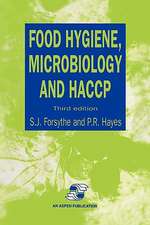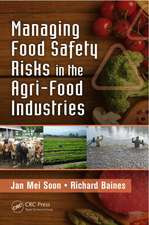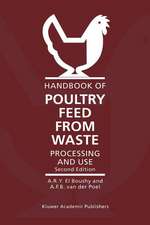Foodinformatics: Applications of Chemical Information to Food Chemistry
Editat de Karina Martinez-Mayorga, José Luis Medina-Francoen Limba Engleză Hardback – 5 dec 2014
| Toate formatele și edițiile | Preț | Express |
|---|---|---|
| Paperback (1) | 638.76 lei 6-8 săpt. | |
| Springer International Publishing – 10 sep 2016 | 638.76 lei 6-8 săpt. | |
| Hardback (1) | 644.95 lei 6-8 săpt. | |
| Springer International Publishing – 5 dec 2014 | 644.95 lei 6-8 săpt. |
Preț: 644.95 lei
Preț vechi: 758.77 lei
-15% Nou
Puncte Express: 967
Preț estimativ în valută:
123.45€ • 134.14$ • 103.77£
123.45€ • 134.14$ • 103.77£
Carte tipărită la comandă
Livrare economică 21 aprilie-05 mai
Preluare comenzi: 021 569.72.76
Specificații
ISBN-13: 9783319102252
ISBN-10: 3319102257
Pagini: 251
Ilustrații: XII, 251 p. 51 illus., 39 illus. in color.
Dimensiuni: 155 x 235 x 20 mm
Greutate: 0.54 kg
Ediția:2014
Editura: Springer International Publishing
Colecția Springer
Locul publicării:Cham, Switzerland
ISBN-10: 3319102257
Pagini: 251
Ilustrații: XII, 251 p. 51 illus., 39 illus. in color.
Dimensiuni: 155 x 235 x 20 mm
Greutate: 0.54 kg
Ediția:2014
Editura: Springer International Publishing
Colecția Springer
Locul publicării:Cham, Switzerland
Public țintă
ResearchCuprins
1. Introduction to Molecular Similarity and Chemical Space.- 2. The Chemical Space of Flavors.- 3. Chemoinformatics Analysis and Structural Similarity Studies of Food-Related Databases.- 4. Reverse Pharmacognosy: A Tool to Accelerate the Discovery of New Bioactive Food Ingredients.- 5. Molecular Approaches to Explore Natural and Food-Compound Modulators in Cancer Epigenetics and Metabolism.- 6. Discovery of natural products that modulate the activity of PPARgamma: a source for new antidiabetics.- 7. DPP-IV, An Important Target for Anti-diabetic Functional Food Design.-8. Comparison of Different Data Analysis Tools to Study the Effect of Storage Conditions on Wine Sensory Attributes and Trace Metal Composition.- 9. Software and Online Resources: Perspectives and Potential Applications.
Notă biografică
The explosion in the generation of information parallels the explosion of computational resources. The use of computers to collect, store and manipulate chemical information is at the heart of chemoinformatics. These methodologies, whose main target thus far has been the pharmaceutical field, are general and can be applied to other types of chemical data sets, such as those containing food chemicals. While the use of chemical information methodologies to address food-related challenges is still in its infancy, interest is growing and will continue to do so as the methods prove useful, particularly for providing practical solutions to food industry challenges. Foodinformatics gives an overview of basic concepts, applications, tools and perspectives of the emerging field of foodinformatics. The book is an important addition to the literature and will be of interest of food chemists, nutritionists, informaticians and scientists of related fields.
About the Editors
Karina Martínez-Mayorga, Instituto de Química, UNAM, Mexico City, México and Torrey Pines Instiute for Molecualr Studies, Port St. Lucie, FL, USA
José Luis Medina-Franco, Instituto de Química, UNAM, Mexico City, México, and Torrey Pines Instiute for Molecualr Studies, Port St. Lucie, FL, USA
About the Editors
Karina Martínez-Mayorga, Instituto de Química, UNAM, Mexico City, México and Torrey Pines Instiute for Molecualr Studies, Port St. Lucie, FL, USA
José Luis Medina-Franco, Instituto de Química, UNAM, Mexico City, México, and Torrey Pines Instiute for Molecualr Studies, Port St. Lucie, FL, USA
Textul de pe ultima copertă
The explosion in the generation of information parallels the explosion of computational resources. The use of computers to collect, store and manipulate chemical information is at the heart of chemoinformatics. These methodologies, whose main target thus far has been the pharmaceutical field, are general and can be applied to other types of chemical data sets, such as those containing food chemicals. While the use of chemical information methodologies to address food-related challenges is still in its infancy, interest is growing and will continue to do so as the methods prove useful, particularly for providing practical solutions to food industry challenges. Foodinformatics gives an overview of basic concepts, applications, tools and perspectives of the emerging field of foodinformatics. The book is an important addition to the literature and will be of interest of food chemists, nutritionists, informaticians and scientists of related fields.
About the Editors
Karina Martínez-Mayorga, Instituto de Química, UNAM, Mexico City, México and Torrey Pines Instiute for Molecualr Studies, Port St. Lucie, FL, USA
José Luis Medina-Franco, Instituto de Química, UNAM, Mexico City, México, and Torrey Pines Instiute for Molecualr Studies, Port St. Lucie, FL, USA
About the Editors
Karina Martínez-Mayorga, Instituto de Química, UNAM, Mexico City, México and Torrey Pines Instiute for Molecualr Studies, Port St. Lucie, FL, USA
José Luis Medina-Franco, Instituto de Química, UNAM, Mexico City, México, and Torrey Pines Instiute for Molecualr Studies, Port St. Lucie, FL, USA
Caracteristici
Covers a burgeoning field Summarizes the basic principles of chemical information to offer analyses to food chemists Presents food chemistry applications already in use to the chemoinformatician in order to broaden the scope of chemical information outside or along with drug discovery Includes supplementary material: sn.pub/extras























